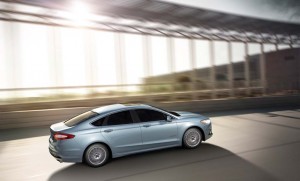The 2013 Ford Fusion has snatched the brass ring, winning certification as the most fuel-efficient model in the critical midsize passenger car segment.
According to the Environmental Protection Agency, which has the last word on the mileage numbers that appear in a vehicle’s Munroney, or window, sticker, the hybrid version of the 2013 Ford Fusion gets 47 miles per gallon. And that number holds for the new model’s city, highway and combined ratings, an unusual bit of news. In the highway category, the 2013 Fusion’s numbers are 8 mpg better than the current midsize champ, the Toyota Camry Hybrid, with a 4 mpg advantage in the city.
Ford didn’t displace the new king-of-the-hill when it comes to its conventionally powered Fusion, however. The EPA says the Fusion with a 1.6-liter EcoBoost inline-four still lags one mile per gallon behind the 38 mpg Nissan Altima, itself newly remade for 2013.
The midsize market, one of the largest segments in the U.S. auto industry, will be a veritable battleground for 2013, with all-new offerings from makers including Ford, Nissan and Honda which is launching its latest Accord. Chevrolet will have a new version of the Malibu Toyota will tweak the Camry and offer at least one new version. And Hyundai, Kia and Volkswagen will push to maintain the strong momentum of their Sonata, Optima and Passat models.
Ford hopes to win over buyers with a mix of features including a radical new design that has already won strong kudos, as well as a mix of advanced safety and comfort technologies such as the latest Sync and MyFordTouch entertainment systems.
“The new Fusion is part of our plan to offer vehicles with the very best quality, fuel efficiency, safety, smart design and value,” said Ford Chief Executive Alan Mulally. “We are absolutely committed to class-leading fuel efficiency as a reason to buy Ford vehicles.”
But fuel economy is clearly at top of mind, the single highest factor that buyers consider right now, according to Mark Fields, Ford’s President of the Americas.
So, getting what amounts to a seal of approval from the EPA could give the 2013 Ford Fusion a solid leg up on the competition.
Ford plans to offer a variety of different powertrains in the new sedan. That includes a plug-in hybrid version to be known as the Ford Fusion Energi that will debut later in the model-year. It will use a driveline lifted largely intact from the maker’s new C-Max microvan and could yield a rating nudging close to 100 using the EPA’s miles-per-gallon-equivalent system – which takes into account the time the vehicle will be driven solely on battery power.
The 47 mpg figure is for the more conventional 2013 Ford Fusion which uses a drivetrain similar in concept to the Toyota Camry and Prius hybrids. It starts out with a 2.0-liter inline-four running the more efficient Atkinson Cycle and producing 141 horsepower and 129 lb-ft of torque. That’s paired to an electric motor drawing power from a lithium-ion battery pack.
That could be the key to Ford’s mileage advantage as LIon batteries can store more energy – recaptured during braking and coasting – than the nickel-metal hydride batteries used by Toyota. The 2013 Fusion can operate in battery-only mode but only for a mile or so and at speeds only up to 62 mph.
The dedicated Toyota Prius still beats the Fusion — but only by a narrow 3 mpg, at 50 miles per gallon.
Ford also will offer three conventional gasoline powertrains, including;
- A 1.6-liter EcoBoost delivering 25 mpg City, 37 mpg Highway, 29 mpg Combined;
- A 2.0-liter EcoBoost delivering 22 mpg City, 33 mpg Highway, 26 mpg Combined; and
- A naturally aspirated 2.5-liter engine yielding 22 mpg City, 36 mpg Highway, 26 Combined.
The 1.6-liter I-4 can also be ordered with Ford’s optional stop/start system for $295. By instantly shutting off the engine instead of idling, say, at a stoplight, then automatically firing back up when the driver’s foot lifts off the brake the technology is expected to yield fuel savings of about 3.5%, Ford claims.

